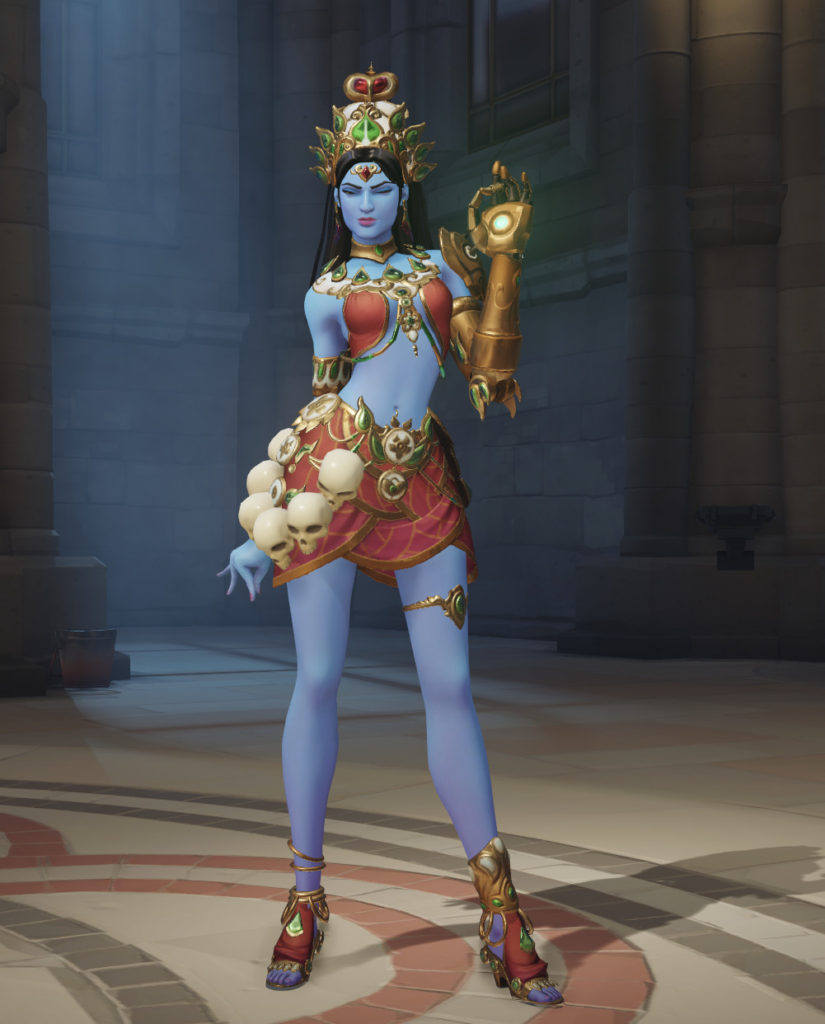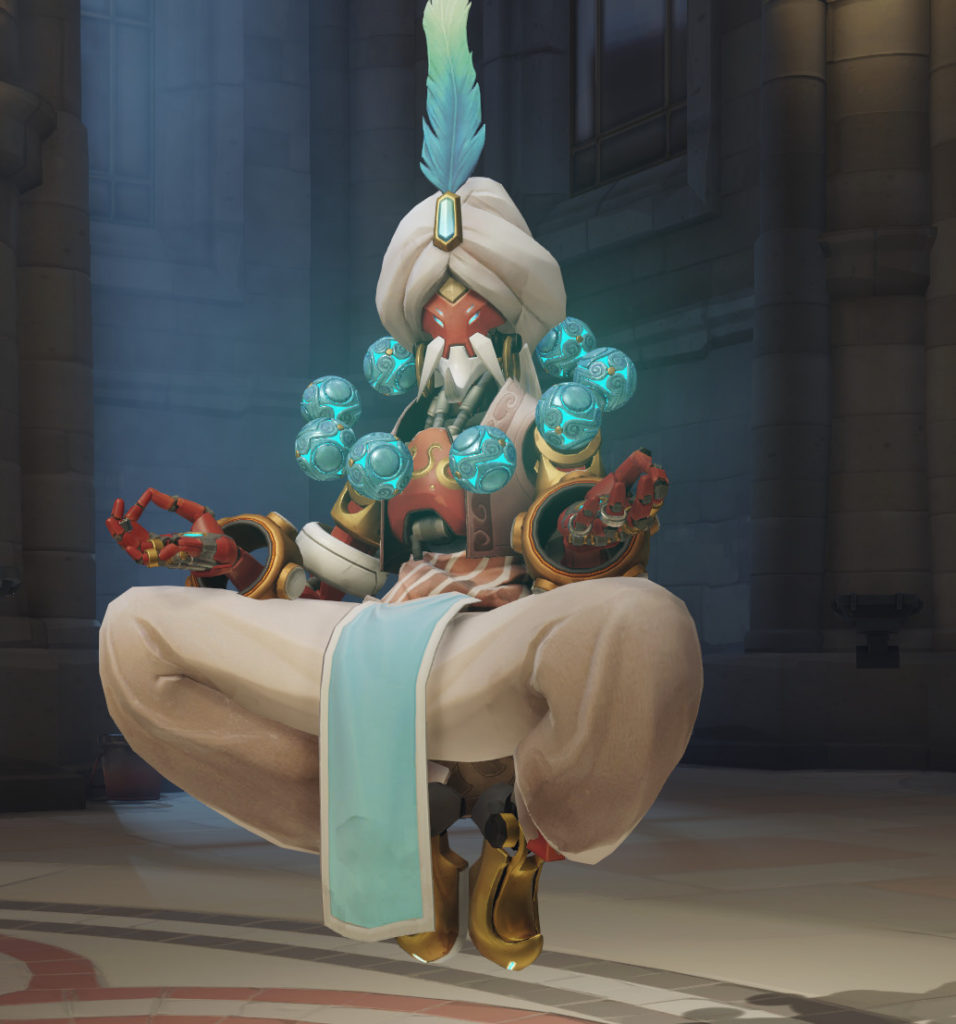One of the most appealing aspects of Overwatch is its colorful cast of characters, which in total represent a mix of global demographics. Among them are the rebellious Brazilian outlaw DJ Lucio, the meticulous Indian architect Symmetra, stout Russian bodybuilder Zarya, dedicated jetpack trooper Pharah, and idealistic Chinese climatologist Mei. The wide reach of these depictions is undoubtedly a positive step for representation in videogames, but it, unfortunately, isn’t without its hiccups.
A number of alternate costumes or “skins” for characters contain cultural features portrayed in a way that isn’t so praiseworthy. The discussion around these skins and their traits has been scant to date, mostly commented on via Twitter, on Battlenet’s forums, and a fan letter on Giant Bomb East’s podcast.
It bears mentioning that cultural appropriation is a hot button issue that coincides with diverse media representation. (A video by MTV Decoded and Nightly Show contributor Franchesca Ramsey sums it up). The line is blurry in Overwatch because, in some cases, the skins were based on an exaggerated portrayal that doesn’t correspond with a culture that’s practiced in the present. Furthermore, the fictional characters themselves aren’t able to appropriate when they wear another group’s outfit as an alternate skin, because they lack the agency to take from another culture and oppress the originators (the latter being the prime factor in the discussion around cultural appropriation).
That said, Overwatch’s futuristic setting seems less affected by the historical grievances that influence cultural appropriation in today’s world. In Overwatch, corporate power and the aftermath of the Omnic Crisis seems to have supplanted ethnic tensions and institutional racial discrimination.
It may make sense that Symmetra, a character of South Asian origin, can dress like a goddess native to her region. However, which deity does the Devi and Goddess skins represent? While Hindu deities come in a variety of representations across regions and Hindu doctrines, features of the alternate skin contrast with historical art portraying them.

The identifiable features of the Devi/Goddess skin include an ornate “mukut” crown with a peacock feather pattern, and a revealing dress most resembling statues in South India, but not quite one-to-one. The garland of skulls around Symmetra’s waist denotes Kali, who often wears a necklace of skulls or freshly decapitated heads around her neck. The blue skin tones also denote Rama, Krishna and Shiva, and various depictions of Kali with blue skin. Kali is the likeliest influence to the Devi/Goddess skins. The problem is Kali’s role as a vicious slayer seems out of character for Symmetra’s lore as an architect and her in-game role as support, with abilities such as shielding teammates and building teleporters.
Pharah’s Thunderbird and Raindancer skins are another faulty depiction. The design of the skin’s armor, including the torso, shoulder pads, wings, and helmet denote influence from people of the Pacific Northwest—the Haida people’s totems are the best known in popular culture. Her face paint is most likely influenced by the Mohawk people in Ontario, Quebec, and upstate New York. This is another example of traits from different groups thrown together without regard for their origins. Furthermore, the theme of Pharah’s alternate skin is the only place Native American culture appears in Overwatch.
Roadhog’s Toa and Islander skins appear to be influenced by Polynesian culture. But the similarities among Polynesian groups makes it challenging to identify the exact inspiration for these skins. The sharktooth hook most resembles a fish hook club from Hawaii, though most of its kind don’t come in the shape that Roadhog’s hook does. The Toa’s Clothing most resembles a piece called called a kiekie, a girdle from Tonga with braided strands falling down to the knees. The braiding is wrapped thick to look more like a hoof to match Roadhog’s character.
The tattoos on the Islander skin most resemble Maori body tattoos, which may denote one’s family, status, and accomplishments. While the mask most resembles a Tiki-style mask, and the designers at Blizzard have renovated it into a pig shape to fit the hog theme of the character. Much of America’s conception of Polynesian visual design comes from kitschy and stereotypical post-WW2 Tiki bars. Whatever the developer’s influences were, the similarity with Tiki design elements contribute to the accusation of appropriation.
Zenyatta’s Djinnyatta and ifrit skins are likely inspired by Orientalist depictions of djinn, from which we derived the word genie. Now, influential scholar Edward Said published Orientalism in 1978. The book reviews the artistic and scholarly trend in Europe of exaggerating Asian cultures, especially the Middle East, in a way that enabled ‘othering’ of the region. Othering can exist as either hateful stereotyping or idealistic fetishizing that enables colonization and exploitation. It’s worth bearing this in mind when looking at Zenyatta’s alternate skins.

Djinnyatta’s baggy pants resemble the “harem pant” of French designer Paul Poiret. The pants and vest were influenced by loose pants in Turkey and South Asia, but the inseam in Poiret’s pant was more exaggerated, dropping down to the calf to allow freer movement than women’s clothing of the time allowed.
Many of these cultural costumes exist in a blurry ground between cultural appropriation and direct stereotypes. On one hand, the mixed up traits don’t correspond to a practiced culture. However, many of these designs were derived from appropriative trends and stereotypical portrayals of the past—such as American Tiki bars, stereotypical depictions of Native groups, and European Orientalist fashion. Replicating the exaggerated features shows a lack of research into these lived cultures, or at least a selective ignorance.
As for skins with Ancient Egyptian or Norse traits, centuries of invasions and conversions have subsumed those cultures into the vague status of the common heritage of mankind. That distinction is not without controversy—institutions such as the British Museum lay claim to artifacts stolen from colonized lands. (2013’s Civilization V: Brave New World simulates this as the archeologist unit and antiquity sites. Other civilizations in the game are never pleased when you choose to extract their artifacts for your museums.)
But the harm of exploiting deities of defunct religions is separate from misrepresenting living cultures that lack representation today. While Mercy’s Valkyrie skins may exaggerate depictions of Norse culture, it is no longer a widely-practiced one. The descendants of the Norse also have ample opportunity to represent themselves in the global media landscape. Native Americans, Pacific Islanders, and South Asians practice a “living” culture, but don’t have as much opportunity. It’s this vital difference that causes issues to be found in Overwatch’s range of skins.
Researching a character’s culture to build a positive and credible representation takes some legwork, but game designers have done so to good effect. For the 2013 reboot of fighting game Killer Instinct, the designers consulted with an ethnographer of the Nez Perce nation to redesign the Native American character Thunder to make a more respectful portrayal than in past games. In a more crowdsourced instance, Tekken producer Katsuhiro Harada asked Saudi fans on social media for feedback in designing Tekken 7’s Saudi character Shaheen. Harada in turn encouraged Yoshinori Ono from Capcom to create Rashid for Street Fighter V.
While Overwatch’s diverse cast should be commended, the developers can improve and build on the theme of global cooperation and diverse representation they seek out.
